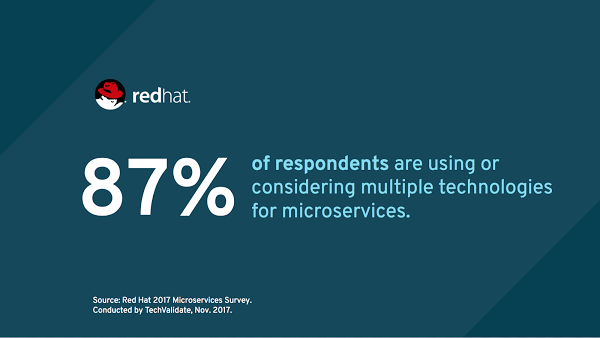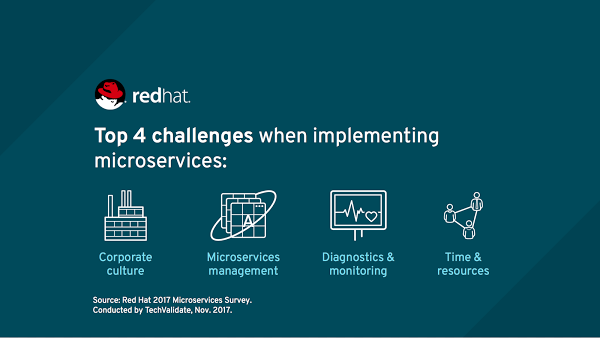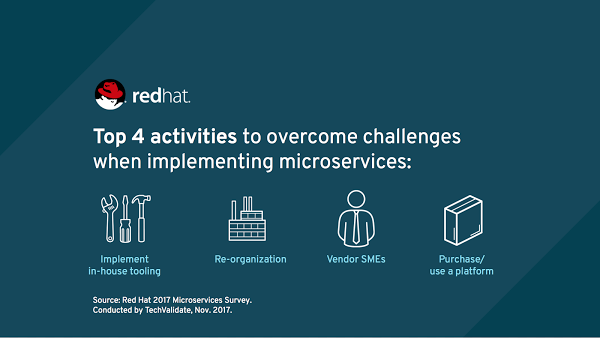During the fall of 2017, we conducted a microservices survey with our Red Hat JBoss Middleware and Red Hat OpenShift customers. From this, we were able to discover how these customers are using microservices to their advantage, what they see as some of the major benefits, what challenges exist and how to overcome them and how microservices can give respondents a competitive advantage. While these statistics are based off of a specific group of Red Hat customers, these findings give a good sense of the overall attitude toward microservices adoption and implementation. Read on to learn more about these findings.
Microservices are being used for both re-architecting existing applications and for brand new projects and initiatives
Microservices projects tend to be marketed as being best for implementing brand-new projects, without mentioning the benefits they bring to upgrading existing projects; however, the survey revealed that respondents are also using microservices to successfully re-architect existing and legacy applications. Sixty-nine (69) percent of respondents indicated that they are using microservices for both new applications and for re-architecting existing ones. Based on this data, it can be understood that microservices offers value to users throughout their IT transformations -- from updating a current portfolio to introducing brand new initiatives.

Customers prefer a multi-runtime/multi-technology/multi-framework approach for microservices
Through this survey, it became clear that there is no single runtime platform or framework that is the best for microservices. We also learned that 45 percent of respondents believe in “using the right tool for the right task,” rather than dedicating themselves to a single technology, runtime or framework.

The survey also shows that 87 percent of respondents indicated that they are using or considering multiple technologies for developing microservices.

These responses show that multi-technology solutions are becoming the norm and that more and more organizations simply want to use the right tool for the right task. This is why it is important to have multiple runtimes and frameworks, as not all technology projects function the same and most do not thrive on using the same tools.
Top benefits of microservices adoption
Respondents to our survey identified many benefits that they are already receiving as a result of implementing microservices. The top six benefits respondents noted are as follows:
- Continuous Integration (CI) / Continuous Deployment (CD)
- Agility
- Improved scalability
- Faster time-to-market
- Higher developer productivity
- Easier debugging and maintenance

Furthermore, many (33 percent) of respondents recognized the benefits within two to six months of first implementing microservices, meaning that the ramp up time is a quick process and benefits can be observed very quickly.

Challenges of implementing microservices
Implementing microservices will not solve all of your software and enterprise problems and in fact, microservices can come with its own set of challenges. According to the survey, the top four challenges to implementing microservices that respondents faced include:
- Corporate culture and organizational challenges
- Microservices management
- Diagnostics and monitoring
- Time and resources
Conversely, the top four activities that respondents identified to help mitigate these challenges were:
- Developing/implementing in-house microservices tooling
- Re-organization
- Working with vendor subject matter experts / Using a vendor as a trusted advisor
- Purchasing or using a microservices platform / solution
Respondents to the survey indicated that they have been relying on vendors as their trusted advisors when it comes to microservices. In addition, many responded that a reorganization was a mitigating activity to get past the microservices challenges in relation to corporate culture. This indicates that it is critical to have a plan in place to evaluate microservices solutions that are available in the market and do due diligence to select the one that best fits individual requirements. The reorganization of teams to incorporate new technologies and inspire change is also a recommended course of action.

Introducing microservices can be disruptive to the way organizations are used to working; however, the results from this survey are promising. These respondents – and we would argue the industry at large – understand both the benefits and challenges of microservices, and are adapting their application strategies accordingly to better meet the demands of the new digital economy.
執筆者紹介
Red Hat is the world’s leading provider of enterprise open source solutions, using a community-powered approach to deliver high-performing Linux, cloud, container, and Kubernetes technologies.
チャンネル別に見る
自動化
テクノロジー、チームおよび環境に関する IT 自動化の最新情報
AI (人工知能)
お客様が AI ワークロードをどこでも自由に実行することを可能にするプラットフォームについてのアップデート
オープン・ハイブリッドクラウド
ハイブリッドクラウドで柔軟に未来を築く方法をご確認ください。
セキュリティ
環境やテクノロジー全体に及ぶリスクを軽減する方法に関する最新情報
エッジコンピューティング
エッジでの運用を単純化するプラットフォームのアップデート
インフラストラクチャ
世界有数のエンタープライズ向け Linux プラットフォームの最新情報
アプリケーション
アプリケーションの最も困難な課題に対する Red Hat ソリューションの詳細
オリジナル番組
エンタープライズ向けテクノロジーのメーカーやリーダーによるストーリー
製品
ツール
試用、購入、販売
コミュニケーション
Red Hat について
エンタープライズ・オープンソース・ソリューションのプロバイダーとして世界をリードする Red Hat は、Linux、クラウド、コンテナ、Kubernetes などのテクノロジーを提供しています。Red Hat は強化されたソリューションを提供し、コアデータセンターからネットワークエッジまで、企業が複数のプラットフォームおよび環境間で容易に運用できるようにしています。
言語を選択してください
Red Hat legal and privacy links
- Red Hat について
- 採用情報
- イベント
- 各国のオフィス
- Red Hat へのお問い合わせ
- Red Hat ブログ
- ダイバーシティ、エクイティ、およびインクルージョン
- Cool Stuff Store
- Red Hat Summit

